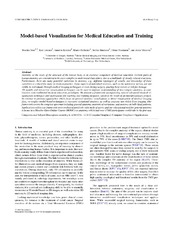| dc.description.abstract | Anatomy, or the study of the structure of the human body, is an essential component of medical education. Certain parts of human anatomy are considered to be more complex to understand than others, due to a multitude of closely related structures. Furthermore, there are many potential variations in anatomy, e.g., different topologies of vessels, and knowledge of these variations is critical for many in medical practice. Some aspects of individual anatomy, such as the autonomic nerves, are not visible in individuals through medical imaging techniques or even during surgery, placing these nerves at risk for damage. 3D models and interactive visualization techniques can be used to improve understanding of this complex anatomy, in combination with traditional medical education paradigms. We present a framework incorporating several advanced medical visualization techniques and applications for teaching and training purposes, which is the result of an interdisciplinary project. In contrast to previous approaches which focus on general anatomy visualization or direct visualization of medical imaging data, we employ model-based techniques to represent variational anatomy, as well as anatomy not visible from imaging. Our framework covers the complete spectrum including general anatomy, anatomical variations, and anatomy in individual patients. Applications within our framework were evaluated positively with medical users, and our educational tool for general anatomy is in use in a Massive Open Online Course (MOOC) on anatomy, which had over 17000 participants worldwide in the first run. | en_US |
